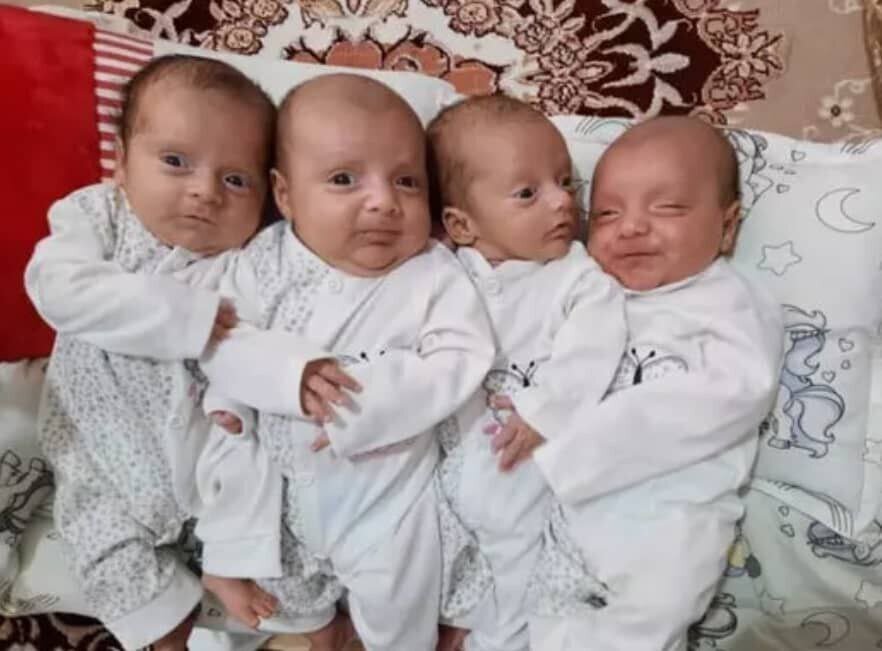Over 14,000 multiple births registered in 9 months

TEHRAN –Within the first nine months of the current Iranian calendar year (started March 20, 2024), 14,090 multiples were born in the country, according to the Civil Registration Organization.
Out of the registered multiple births, 13,565 were twins, 504 were triplets, 19 were quadruplets, and 2 were higher-order multiple births, IRNA reported.
Tehran, Khuzestan, and Khorasan Razavi provinces had the highest number of multiple births with 2,127, 1,207, and 1,186 cases, respectively.
A total of 734,249 births were registered in the country over the nine-month period. Approximately, four percent of the births (that is 28,728 babies) were multi-birth deliveries.
Tehran province with 89,325 births, and Ilam province with 4,963 births had the highest and lowest number of births, IRNA reported.
According to the Civil Registration Organization, more than 36.8 percent of the births in the first eight months of the current calendar year were second-born children.
First-born children accounted for 36 percent of the births. Over 36.8 percent, 18.7 percent, and 8.5 percent were related to second-born to fourth-born children, respectively, IRNA reported.
Over 1m births registered in a year
According to the Civil Registration Organization, a total of 1,057,948 births were registered in the country in the past Iranian calendar year (March 2023-March 2024).
Second-born children with 405, 993 births accounted for the highest number of registered births.
Tehran province with 131,176 births and Semnan province with 6,907 births had the highest and lowest number of births, IRNA reported.
Out of registered births, 51.8 percent were boys and 48.2 percent were girls.
According to the Organization, a total of 33,080 multiple births were registered in the country in the first ten months of the past Iranian calendar year that ended on March 20, 2024.
Twins made up the majority of multiples born; 31,320 out of 33,080 registered multiple births were twins, and 1,686 births were triplets, IRNA reported.
Tehran province with 14.7 percent and Semnan province with 0.5 percent had the highest and lowest number of multiple births, respectively.
Last year, out of the registered multiple births in the first nine months, 28,148 were twins, 1,506 were triplets, 64 were quadruplets, and 10 were higher-order multiple births.
Some 34.6 percent of registered births were first-born children; 38.9 percent, 17.6 percent, 5.1 percent, and 2 percent were related to second-born to fifth-born children.
In the first nine months of the past Iranian calendar year, more boys than girls were born. Over 51.8 percent of babies born were boys and 48.2 percent were girls.
Population aging five times faster than growth
According to the latest census, the number of aged citizens in the country is growing by 3.62 percent which is five times faster than the total population growth rate, which is 1.24 percent.
In Iranian year 1385 (2006-2007), there were 5,121,043 men and women aged above 60. In 2015, 10 percent of the country’s population was older than 60, ISNA quoted Mohammad-Javad Mahmoudi, an official with the National Institute for Population Research.
In the next 30 years, the population aged 60 years or older is projected to hold a 32 percent share of the whole population, that is, the elderly will account for one-third of Iran’s population by 2050, the official noted.
Currently, men and women aged above 60 constitute some 11.5 percent of Iran’s population, an official with the health ministry has said.
It is one of the most important challenges facing the country.
“At best, Iran’s population with a total fertility rate of 2.5 will reach 102,890,000 by the next seven years,” IRIB quoted Mahmoudi as saying.
In the last two years, the fertility rate has stabilized around 1.6 which has intensified concerns over the decreasing trend in population growth in the coming years, and the probability of turning Iran into one of the oldest countries in the world, the official highlighted.
MT/MG
Leave a Comment